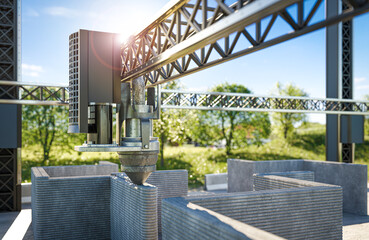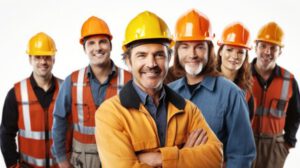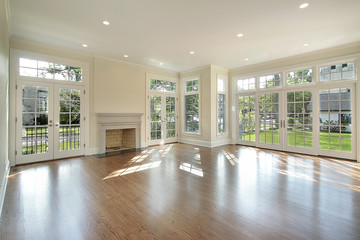Flooring Installation Helena MT should withstand the rigors of daily living. It should also be easy to clean, especially in damp areas. Linoleum is made from natural materials like linseed oil and wood flour and resists fading from sunlight. It’s perfect for homes with kids and pets and is a good option to minimize the impact on forests and greenery.

Wood floors are one of the most popular choices for flooring. They look beautiful and are a great addition to any home. When properly cared for, hardwood can last for generations. It can be sanded down and refinished several times to extend the floor’s life. The most important thing to remember when caring for wood floors is to protect them from moisture. Moisture causes your floors to expand and contract, which can cause damage.
The process of making hardwood begins with cutting logs into rough planks. The logs are kiln dried to reduce moisture content and prevent them from cracking or warping during the manufacturing process. They are then sawed into rough boards, which can be cut three different ways: flat-sawn, quarter sawn and rift sawn. Each method yields a unique grain pattern. The planks are then trimmed of any additional imperfections and visually inspected before they are grouped for finishing.
Most solid wood flooring planks are 3/4 inch thick and are between 2-1/4 and 4 inches wide. They are available in lengths from 12 to 84 inches. Wider planks are available, however, at a premium price. Engineered wood flooring can also be made in wider widths.
To maintain your hardwood floors, sand them occasionally with a drum or orbital sander to refresh the surface and keep it looking like new. If you notice scuff marks or other signs of wear, wipe them down with a damp cloth and blot dry. Then, use a commercially available wood floor finish such as Minwax or a water-based polyurethane to protect the surface. Be sure to follow the manufacturer’s instructions for application and drying times.
Laminate
Laminate discreetly made its way into our homes more than forty years ago and it’s not going anywhere soon. While it may seem like a faux alternative to wood flooring, modern laminate is surprisingly realistic and offers an affordable solution for those who prefer a less expensive style that can withstand the daily wear and tear of children and pets.
The first layer in any laminate is the pattern layer, essentially a photographic image that gives the flooring its distinctive appearance. The photographs are segmented into sections the size of a laminate plank, creating a variety of grain patterns that mimic natural wood grains. Pearl-sheen inks add dimension to the decorative images, further increasing the realism of the flooring.
Next comes the core board, a dense fiberboard that’s bonded with resin to create a strong and durable material. The core boards are milled to micron-precise tolerances that allow them to fit together and form a stable, reliable plank during installation according to one of four locking systems.
Finally, the decorative paper is layered on top of the core boards, creating a unique and customizable laminate design. This high-quality printed surface can be a realistic reproduction of wood, stone or marble, but it can also include non-traditional designs, such as leaves, grass or art work.
Once the four layers are stacked they’re sent to a press, which applies tremendous pressure in order to bond and cure them into one solid piece of decorative laminate. The press can even incorporate specialized plates that imprint the layers with a textured surface to create more natural-looking laminate planks and tiles. The finished product is a durable, easy to clean floor that can last for decades with proper maintenance and care.
Tile
Tile can enhance the beauty of your home whether it’s used to create a colorful backsplash in your kitchen or a dramatic art-deco floor in your bathroom. It is extremely durable and can stand up to high traffic, although it does require a little care and maintenance to keep it looking beautiful. Tile is also hypoallergenic, unlike some carpeting, and does not harbor dust mites or mold. Additionally, it’s moisture resistant, which helps reduce the occurrence of mildew, reducing your need for air conditioning and keeping your utility bills lower.
A number of steps must be taken to produce a finished tile, including batching, mixing and grinding, spray-drying, forming, drying, glazing, and firing. Most tile is made from clay, but other materials can be used, including glass, stone and metal. The strength of a tile is determined by its thickness and composition, as well as the temperature and duration of firing. A glaze is applied to the surface of a tile after it has been fired in order to provide color and resistance to moisture.
The firing process takes place in kilns that are either heated with natural gas, electric or wood fuel. In addition to temperature, the length of time the kiln is exposed to the intense heat significantly impacts the quality of the tile.
A tile floor should be “dry cleaned,” or swept and vacuumed, on a weekly basis to remove debris and loose dirt that can scratch or dull the finish. A bucket and mop should be used to apply a gentle commercial-grade cleaning product that is compatible with your type of tile. This solution should be rubbed into the tile and grout, allowed to stand for 3 – 5 minutes, scrubbed with a sponge or broom, and rinsed thoroughly.
Concrete
Concrete is a durable and sturdy construction material that is used for streets and driveways, and also offers the potential to be quite beautiful when used as a floor in homes. Concrete floors are often honed or polished to create a glass-smooth surface that is attractive and easy to clean. The surface is also easily stained and colored in a wide variety of ways to meet the individual design preferences of homeowners.
Concrete floors can be constructed using a variety of methods, including precast slabs that are manufactured off-site and then delivered to the construction site to be laid. These slabs are usually designed to match the expected load bearings and other specific requirements of the building project, and they are poured onto a sub-base that has been carefully prepared by civil engineers.
Once the concrete is poured, it is left to set before the final finishing process begins. During this phase, concrete can be honed or polished, sandblasted, texturized, stenciled or airbrushed, and stained with a variety of pigments to create works of walkable art that complement the rest of the room décor.
Once the concrete is completed, it is sealed to help protect the surface from moisture and prevent mold or mildew growth. Ideally, these floors should be re-sealed every two to five years to ensure that they maintain their beauty and durability. Concrete floors are one of the easiest flooring materials to maintain, but they do require some care in order to keep them looking their best. For example, it is important to sweep and dust mop regularly in order to remove any dirt or debris that might otherwise damage the slick concrete surface. It is also a good idea to use rubber mats in areas of the home where the floors will get the most foot traffic, as this helps to reduce wear and tear on the concrete.
Natural Stone
Natural stone is a non-man made material that comes directly from the earth. It can be found in a variety of forms including marble, travertine, limestone, granite and slate. Whether used in floor tile, mosaics or ledger panels, natural stone offers a beautiful and unique look to any home. While it does require more maintenance than other flooring materials, it is durable and typically better for resale.
Like all other tiles, natural stone can be honed and polished for an elegant sheen or matted and tumbled for a more rustic texture. It is also available in a wide range of finishes such as leather, cleft, flamed, sandblasted and split face.
Because of the inherent qualities of each piece, no two pieces of natural stone will look exactly the same. This adds to its charm and beauty, giving it a one-of-a-kind personality. Irregular markings, lines, veining and crystallization are not defects or imperfections but rather a natural part of the stone.
Many types of natural stone are water resistant and can be used in areas prone to moisture, such as bathrooms. However, they should be properly sealed to ensure the longevity of the stone.
If the sealant on a natural stone surface becomes worn, it will need to be reapplied. Moisture damage can occur when water that seeps through the surface seeks a pathway to evaporate, usually through natural cracks in the structure of the stone or through its veining. The moisture can carry salts with it that are left behind as a white powdery substance, known as efflorescence. This damage can be minimized by regular washing of the stone with clean, potable water and a neutral (pH 7) cleaner.












